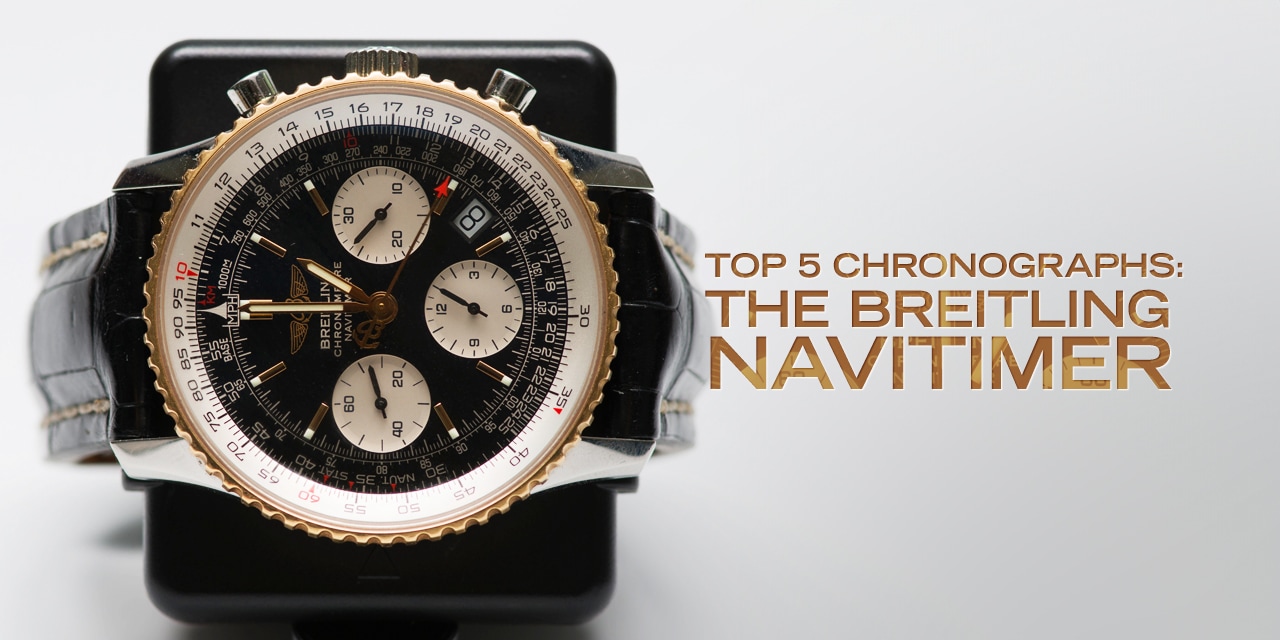The Top 5 Chronographs: The Breitling Navitimer
There are a number of watches so distinctive they are impossible to mistake for anything else.
Some find their particular form purely for aesthetic reasons; the Patek Nautilus, for instance, was styled in the eccentric way it was simply because it looked good.
Others, however, have become inimitable through necessity. Jaeger-LeCoultre’s Reverso gained its signature rotating case in order to shield the dial from damage while its wearer played polo, Panerai’s Luminor grew its side crescent moon to protect the winding crown, etc.
Yet, it is hard to think of a more idiosyncratic example of form-following-function than the Breitling Navitimer.
It is to pilot watches what the Rolex Submariner is to divers; the single model which defines the genre and is completely and utterly inseparable from it. But that is where the similarities end. While the Sub is held up as the pinnacle of clean minimalist design, the Navi is just about the most convoluted-looking creation there is.
An icon since its inception, it is now in its 70th year and still at the top of every aviator’s wish list, as well as that of plenty of others whose feet never leave Terra Firma.
Taking the number three spot on our list of the best chronographs of all time, this is the Navitimer’s story.
A Little History
Breitling had been a leader in both chronographs and aviation timepieces long before their emblematic pilot’s watch merged the two.
Founded in 1884 by Léon Breitling, a German immigrant to Switzerland, the company’s early years were spent crafting highly accurate stopwatches for industrial, scientific and military clients, as well as supplying several professional sports governing bodies.
At the latter end of the 19th century, Breitling invented one of the first models with an eight-day power reserve, as well as a chronograph able to time down to 2/5th of a second.
With Léon’s untimely death in 1914, the business passed to his son, Gaston, who continued his father’s legacy of significant innovations. Gaston it was who, a year into his stewardship, patented the first wristwatch chronograph with an independent ‘pusher at 2’, separating the start, stop and reset control from the crown.
Sadly, Gaston was also to die suddenly, in 1927. He in turn was succeeded by his own son, Willy Breitling, five years later in 1932. With the threat of another world war looming, Willy established his company’s Huit Aviation Department (huit being the French word for ‘eight’ in reference to the power reserve of some of the brand’s timepieces) and by 1939, Breitling timing instruments were serving inside the cockpits of many nations’ military aircraft, including the fabled Lancaster and Spitfire of the British Royal Airforce.
The Birth of the Navitimer
In 1940, Breitling started to branch out into wider markets and, recognizing just how much more utility could be derived from the chronograph complication, released the Chronomat, a model designed specifically for scientists, mathematicians and engineers.
The first wristwatch ever to incorporate a logarithmic slide rule in its bezel, the two-register Chronomat could be used for an entire range of computations—from simple additions, subtractions, multiplications and divisions, through to geometry, exchange rate calculations and telemetry. More importantly, it also laid the foundations for what was to come.
Following WWII and the arrival of the golden age of recreational aviation, pilot’s advocacy group AOPA (Aircraft Owners and Pilots Association) approached Breitling with a request. They recognized the effectiveness of the Chronomat and wanted a version to serve as their official watch that incorporated the E6B flight computer, better known as the pilot’s ‘Whizz Wheel’. Designed by US Naval Reserve pilot Philip Dalton, with the E6B, aviators were able to quickly determine such vital information as an aircraft’s ground speed, fuel consumption, wind drift, ascent and descent rate and a host of others.
Breitling turned to mathematician Marcel Robert to modify the Chronomat’s scale, and he added the three most important units for aviation; NAUT for nautical miles, KM for kilometers and STAT for statute miles.
In 1954, the newly christened Navitimer (shortened from Navigation Timer) was born.
AOPA were the sole recipients of the initial consignment. Records show that Breitling manufactured around 1,100 in the first year of production in small batches of 100 to 300, costing $87.50 each.
Steel, 41mm in diameter, with a tricompax arrangement and without even any Breitling branding on the all-black dial, the extraordinary-looking piece was an immediate hit with AOPA members. The power came from the Valjoux 72 manually-winding chronograph movement, renowned for its accuracy and reliability and that all-important bezel had been given a beaded-edge to allow pilots to turn it while wearing gloves. Strangely, it had no official reference number, but today collectors of these extremely rare and highly valuable pieces refer to them as the ‘pre-806’.
The real 806 was released to the general public in 1956 once it became obvious the Navitimer had an appeal. The Valjoux movement was replaced with a Venus 178 and the dial remained black all over, including the subdials. There were, however, several variations in the text. Earliest examples included AOPA’s signed wings logo, others had the wings without the AOPA signature, others still had unsigned wings and the Breitling logo. Breitling did not actually include its own signature until the late ‘50s.
A gold-plated variant appeared around the same time, as did an incredibly rare solid gold model.
The Navitimer Through the Years
As with any watch, especially one with the longevity of the Navitimer, it took a little while for all the details to be finalized.
The first time the brand produced the now-more recognizable reverse panda dial layout was in 1963 which turned the subdials white to aid readability. The beaded bezel was superseded by one with a scalloped edge in 1964, the change coming to make it easier to manipulate.
Soon, other variants began to appear. The 1806 and 816 debuted in 1969, both sharing the so-called ‘Pizza’ case, measuring a massive 48mm. The main difference between the two lay in the caliber. The 816 retained the Venus 178, but the 1806 benefitted from the ‘Chrono-Matic’ self-winding chronograph movement Breitling had helped create in the great automatic chrono race which dominated most of the ‘60s. They also fit the Chrono-Matic in the more wearable 41mm 8806 in 1973 which, much like Heuer’s Monaco, came with its winding crown on the left.
The early ‘70s saw the first Navi with a date display. Just as when Rolex did the same with the Submariner, its inclusion split opinion and the hardest of hard core collectors consider this the end point for true Navitimers.
Ill health led to Willy Breitling selling his family company in 1979, at the height of the Quartz Crisis. It was bought by Ernest Schneider, an electronics engineer, aviation enthusiast, and Swiss armed forces veteran. Rather than fight against it, he opted to embrace quartz and adapted the Navitimer to the new technology. The LED display ref. 9106 arrived shortly after Schneider took over, followed by the LCD ref. 9416. Both had the trademark slide rule bezel still, but with digital readouts.
But it wasn’t long before the public started clamoring for traditional mechanics again. The retro-inspired ref. 81600 was unveiled in 1985, complete with manually-wound caliber. Known colloquially as the ‘Serge Gainsbourg’ after the French singer who was a big fan, it was the first Navi to feature Breitling’s winged anchor insignia.
The Navitimer Today
In 2009, Breitling achieved horology’s great milestone and became a fully-fledged manufacture. Their in-house, self-winding, COSC-certified chronograph movement, the B01, started work inside the resurrected Chronomat that year, with the Navitimer following after in 2011.
Georges Kern was installed as CEO in 2018 and set about modernizing the whole portfolio in a major way. A revitalized Navi collection was brought out in 2022, with a host of new color options. Green, blue, silver and copper versions are now available, along with plenty of limited editions, non-chrono examples and two-tone or full-gold pieces. Sizes range from 32mm ladies models up to large 46mm watches and there is even a top-of-the-range perpetual calendar and moonphase.
Today, the Navitimer is as revered as it has ever been, one of the most important and popular names in both chronograph and aviation history. The smart watch of a former era, it sits among watchmaking’s greatest triumphs.







